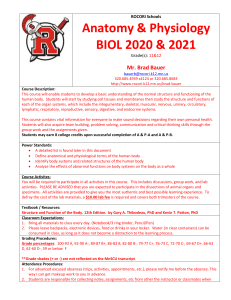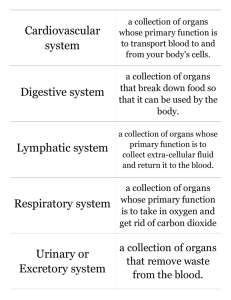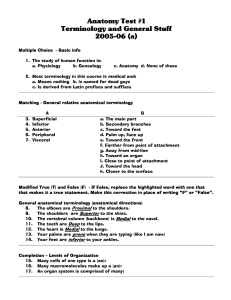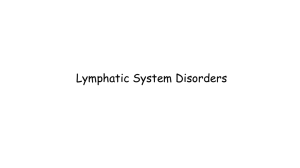Paramedic Program Anatomy and Physiology Study Guide Define
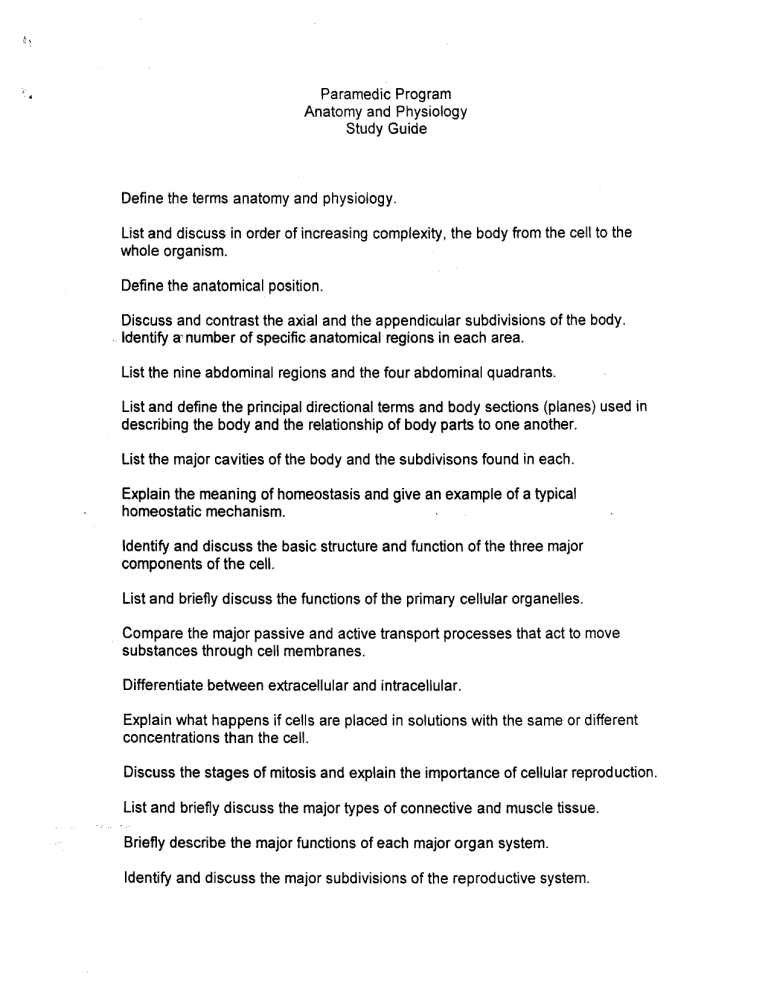
Paramedic Program
Anatomy and Physiology
Study Guide
Define the terms anatomy and physiology.
List and discuss in order of increasing complexity, the body from the cell to the whole organism.
Define the anatomical position.
Discuss and contrast the axial and the appendicular subdivisions of the body.
Identify a- number of specific anatomical regions in each area.
List the nine abdominal regions and the four abdominal quadrants.
List and define the principal directional terms and body sections (planes) used in describing the body and the relationship of body parts to one another.
List the major cavities of the body and the subdivisons found in each.
Explain the meaning of homeostasis and give an example of a typical homeostatic mechanism. ldentify and discuss the basic structl- re and function of the three major components of the cell.
List and briefly discuss the functions of the primary cellular organelles.
Compare the major passive and active transport processes that act to move substances through cell membranes.
Differentiate between extracellular and intracellular.
Explain what happens if cells are placed in solutions with the same or different concentrations than the cell.
Discuss the stages of mitosis and explain the importance of cellular reproduction.
List and briefly discuss the major types of connective and muscle tissue.
Briefly describe the major functions of each major organ system. ldentify and discuss the major subdivisions of the reproductive system.
Describe current approaches to organ replacement.
List and describe the basic mechanisms of disease and risk factors associated with disease.
Classify, compare the structures of, and give examples of each type of body membrane.
Describe the structure and function of the epidermis and dermis of the skin.
Classify burns and describe how to estimate the extent of. burn injury.
Explain how bones are formed; how they grow, and how they are remolded. ldentify the major anatomical structures found in a typical long bone and discuss bone formation and growth.
Differentiate between red and yellow marrow with respect to function and location.
List and discuss the generalized functions of the skeletal system. ldentify the two major subdivisions of the skeleton and list the bones found in each area.
List and compare the major types of joints found in the body and give examples of each type.
Name and describe major disorders of bones and joints.
List, locate in the body, and corlipare the structure and function of the three major types of muscle tissue.
List the substances needed in muscle contraction and describe the function of each.
Explain how muscles work in pairs to produce movement.
List the organs and divisions of the nervous system and describe the generalized functions of the system as a whole.
Identify the major types of cells in the nervous system and discuss the function of each.
Give the locations and functions of the three main divisions of the brain
Name the three meninges.
State the names and function of the twelve cranial nerves, and how to test the function for each.
Compare the sympathetic and parasympathetic nervous systems relative to location and function.
Compare and contrast the propagation of an action potential along a nerve fiber and across a synaptic cleft.
=-- ldentify the major.anatomica1 components of the brain and spinal cord and briefly comment on the functions of each. ldentify and discuss the coverings and fluid space of the brain and spinal cord.
Discuss the spinal and cranial nerves.
Discuss the anatomical and functional characteristics of the two divisions of the autonomic nervous system.
Explain how heat is produced in the body.
List the ways heat is lost from the body
Describe the role of the hypothalamus in regulating body temperature.
Name the structures of the eye.
Describe the three divisions of the ear.
Discuss the anatomy of the ear and its sensory function in hearing and equilibrium.
Distinguish between endocrine and exocrine glands.
Explain how negative and positive feedback mechanisms regulate the secretion of endocrine hormones.
Describe the primary function of blood.
List the formed elements of blood and identify the most important function of each.
Explain the steps in blood clotting.
Name the location, size, and position of the heart in the thoracic cavity and identify the heart chambers, sounds, and valves.
Describe the major types of cardiac valve disorders.
Trace blood through the heart and compare the functions of the heart chambers on the right and left sides.
List anatomical components of the heart conduction system and discuss the features of the normal electrocardiogram.
Describe the major types of cardiac arrhythmia.
List and describe possible causes of heart failure.
Describe the effects of vasodilation and vasoconstriction on blood distribution.
Describe the structure and function of each major type of blood vessel: artery, vein, and capillary. ldentify and discuss the factors involved in the generation of blood pressure and how they relate to each other.
Describe the generalized functions of the lymphatic system and list the primary lymphatic structures.
Define and compare nonspecific and specific immunity, inherited and acquired immunity, and active and passive immunity.
Name the major disorders associated with the lymphatic system.
Discuss and contrast the development and function of B cells and T cells.
Identify the four mechanisms necessary to transmit organisms and infect others.
Compare and contrast humoral and cell-mediated immunity.
Discuss the generalized functions of the respiratory system.
Name the major organs of the respiratory system and describe the function of each.
Explain how carbon-dioxide serves to regulate the pH of the blood
Compare, contrast, and explain the mechanism responsible for the exchange of gasses that occurs during internal and external respiration.
List and discuss the volumes of air exchanged during pulmonary ventilation. ldentify and discuss the mechanisms that regulate respiration. ldentify and describe the major disorders of the upper respiratory tract. ldentify and describe the major disorders of the lower respiratory tract.
List in sequence each of the components, parts or segments of the alimentary canal from the mouth to the anus and identify the accessory organs of digestion.
.-
Describe how bile fun.ctions..in digestion.
List the eight main functions of the liver
Differentiate between anaerobic and aerobic phases of catabolism and give the end products and the relative amount of energy released from each.
Define and contrast catabolism and anabolism.
Define basal metabolic rate and list some factors that affect it.
Discuss the physiological mechanisms that regulate body temperature. ldentify the major organs of the urinary system and give the generalized functions of each.
Name the parts of a nephron and describe the role each component plays in the formation of urine. urine formation.
Explain how the kidneys act as vital organs in maintaining homeostasis.
List the major renal and urinary disorders and explain the mechanisms of each
List, describe, and compare the body fluid compartments and their subdivisions.
Discuss the nature and importance of electrolytes in body fluid and explain the aldosterone mechanism of extracellular fluid and volume control.
Give examples of common fluid imbalances.
Explain how the numbers on the pH scale relate to acidity and alkalinity.
Define the term buffer and buffer pair and contrast strong and weak acids and bases.
Contrast the respiratory and urinary mechanisms of control.
Discuss compensatory mechanisms that may help return blood pH to near normal levels in cases of pH imbalance.
Compare and contrast metabolic and respiratory types of pH imbalances.
List the essential and accessory organs of the male and female reproductive systems and give the generalized function of each.
Discuss the concept of development as a biological process characterized by continuous modification and change.
Discuss the effects of aging on the major body organ systems.
